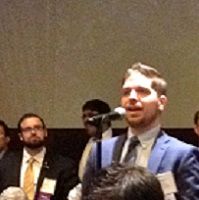Article
Docs Push for Loan Forgiveness
Author(s):
Location should matter more than non-profit status when it comes to forgiving medical school debt for physicians who work in underserved areas, a group of medical residents believes.

Unlike doctors in much of the world, US medical students typically begin their careers carrying a quarter of a million dollars in student loan debt.
At its recent annual meeting in Chicago, IL, the American Medical Association’s House of Delegates passed a resolution to investigate a possible solution: expanding a program that forgives student loans for residents and fellows.
At issue is whether the government should change its Public Service Loan Forgiveness Program (PSLFP) to cover all physicians who work in "public service" jobs such as being doctors in medically underserved areas—even if they work in facilities that are part of for-profit corporations.
The AMA will report back on its examination of mechanisms to expand the forgivable loan program to all residents before its Interim House of Delegates meeting, set for November 12-15TH in Orlando, FL.
Supporters of the proposal from AMA’s Residents and Fellows Section maintain the term “public service” needs further definition when talking about the healthcare industry.

“Regardless of where you work all funding related to training a resident in reality is coming from the government, “said Robert Viviano DO, (photo, right) an emergency medical resident in New York. “The great majority of us qualify for the forgivable loan through residency because lots of teaching hospitals have non-profit status, but the resident really has no direct control over whether they go to a non-profit or for-profit institution.”
Under the PSLFP doctors --as well as law enforcement, teachers, lawyers, corrections officers and librarians-- who have been conscientious with their student loan payments can wipe out the balances that often run into the hundreds of thousands of dollars.
Annual tuition at US medical school is $30,000 - $60,000, putting many graduates into debt that can last decades. French medical students by contrast are responsible for only a few hundred Euros in entrance fees.
In the words of another delegate, a third year resident who spoke at the meeting, “If you don't have a burning desire to actually be a doctor and make it your life practicing medicine, do something else--the debt is crushing and the stress can make people suicidal.”
Written into the 2007 College Cost Reduction and Access Act this federal loan forgiveness program was intended to steer students away from loan companies while stocking the pool of qualified applicants for public sector jobs.
The PSLFP offers some relief but the criteria are strict. To qualify applicants must document timely payment of 120 loan installments and complete ten years of employment at a non-profit or government institution.
Under current Department of Education guidelines the non-profit status is more important than the type of work.
State, local, tribal or federal government employers, tax-exempt 501(c) (3) non-profits, or private non-profits that provide public services such as early childhood education, emergency management, or legal aid all qualify. A stint in AmeriCorps or the Peace Corp counts too.
Viviano’s residency program is under the auspices of a non-profit and its residents care for patients in Harlem, as well as in suburban Westchester County, and he will be eligible for loan forgiveness.
But working in a medically underserved city or region does not count if the facility is part of a for-profit entity.
One problem for new medical school graduates is that landing a residency requires students to submit to a binding agreement without knowing exactly where they will end up in the annual nail-biter known as the National Residency Match.
Indeed the 2015 Residency Match had 41,334 applicants vying for just 30,212 spots. Given those odds few are inclined to be choosey, but for many students PSLFP eligibility will make or break their depending on their financial situation for many students being left out of the loan forgiveness program is a deal breaker.
Mergers and takeovers of healthcare institutions can undermine the intent of the program. For example, residents who match at non-profit Drexel University in Philadelphia, PA can find themselves employed by Tenet Healthcare, a for-profit hospital operator based in Dallas, TX. As employees of a for-profit institution they would not be eligible loan forgiveness.
As a delegate to the AMA’s Resident and Fellows section Viviano testified at the committee hearing in Chicago that the stakes are high for young doctors.
Viviano said he had originally planned to study urology.
A graduate of Touro University, he had given up on finding a position in urology when he got a last minute phone call. An applicant had dropped out of the program at Detroit Medical Center, home to Harper hospital, a teaching institution that first opened its doors in 1864 to civil war soldiers.
Unfortunately he said, he had to turn it down, because he knew he couldn’t afford a position that didn’t qualify for loan forgiveness. Despite its academic role in one of the U.S.’ most economically disadvantaged cities Detroit Medical Center is a for-profit hospital. It was purchased by Tenet in 2013.
That scenario is common and puts many young physicians in a bind, he said.
“You can find yourself forced to choose between facing down your debt and doing what you really want to do,” Viviano said.





